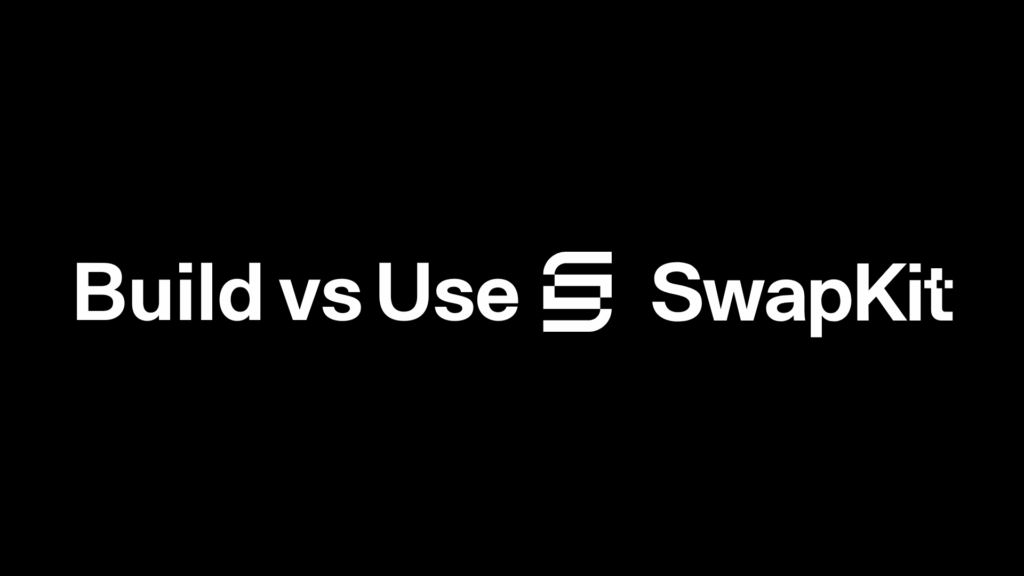
Build vs. Integrate with SwapKit
How to decide between building your own cross-chain swap system and using SwapKit’s SDK.
The Core Question
Every wallet, custodian, or DEX aggregator eventually faces the same decision:
“Should we build our own cross-chain swap logic, or integrate a ready SDK like SwapKit?”
Let’s break down what each approach really involves — in time, cost, reliability, and scope.
Building Cross-Chain Swaps In-House
What You’ll Need to Build
- Blockchain integrations: RPC connections, gas estimation, fee handling for each chain.
- Liquidity provider logic: connection to THORChain, Maya, Chainflip, and NEAR APIs (each with its own quirks).
- Routing & quoting: price discovery, fallback logic, and route optimization.
- Transaction management: inbound/outbound monitoring, refunds, retries, error handling.
- Security & monitoring: uptime alerts, swap failure detection, version updates per provider.
- Compliance: KYT/KYC routing for custodial or regulated entities.
What It Costs
| Cost Type | Est. Effort |
|---|---|
| Initial engineering | 2–4 full-time engineers, 3–6 months |
| Maintenance | Ongoing updates as providers change APIs |
| Uptime coverage | 24/7 monitoring across 4+ networks |
| QA & testing | Continuous due to multi-chain volatility |
Even well-funded teams underestimate the long-term cost of maintaining integrations — especially when providers change liquidity logic, chain IDs, or fee models.
Integrating with SwapKit
What You Get
- Unified SDK & API → access to all major cross-chain providers (THORChain, Maya, Chainflip, NEAR Intents).
- Best route selection → quotes ranked by execution quality, fees, and success rate.
- Native BTC support → real Bitcoin swaps across multiple protocols.
- Destination gas abstraction → no need for users to pre-fund destination gas.
- Failover redundancy → automatic fallback if a provider goes offline.
- Enterprise-ready infra → already powering swaps in Ledger, Trust Wallet, and other leading wallets.
Example: Swap BTC → ETH
import { SwapKitApi } from "@swapkit/sdk";
const quote = await SwapKitApi.getSwapQuote({
sellAsset: "BTC.BTC",
buyAsset: "ETH.ETH",
sellAmount: "0.05",
});
console.log(quote.data.routes[0]);
Within one SDK, you get production-ready routing across THORChain, Maya, Chainflip, and NEAR Intents — with fallback, slippage handling, and error recovery built in.
Side-by-Side Comparison
| Category | Build In-House | Integrate SwapKit |
|---|---|---|
| Time to market | 3–6 months | < 1 week |
| Providers supported | 1–2 (manual) | 4+ (THORChain, Maya, Chainflip, NEAR) |
| Native BTC support | Custom work per chain | Built-in |
| Destination gas abstraction | Requires custom logic | Included |
| Maintenance cost | High | Minimal |
| Routing redundancy | Manual setup | Automatic |
| Reliability | Depends on internal infra | Production-tested |
| Future provider additions | Requires dev time | Included automatically |
Real-World Impact
SwapKit abstracts the complexity of cross-chain liquidity so your team can focus on product differentiation, not plumbing.
Whether you’re a wallet aiming to support native BTC swaps or a custodian offering multi-chain settlement, SwapKit saves months of engineering time and ensures better uptime through provider redundancy.
Frequently Asked Questions
Q: What if I want control over the routing logic?
SwapKit exposes granular control — you can specify which providers or assets to prioritize, or even run your own routing logic on top of it.
Q: Is SwapKit open-source?
Yes. SwapKit’s SDK and toolboxes are open-source and available on GitHub.
Q: Can I integrate SwapKit alongside my existing aggregator?
Yes. Many partners use SwapKit to handle cross-chain routes while keeping their own internal single-chain swap logic.
Related Resources
- Compare Cross-Chain SDKs
- THORChain Provider Page
- Maya Protocol Provider Page